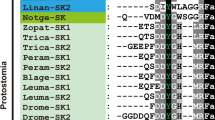Abstract
In Aplysia fasciata, pheromones released by conspecifics with access to mates increase the quantity of food eaten. This effect is blocked when the chemosensory rhinophores are ablated, indicating that the rhinophores sense pheromones. The modulation of feeding by pheromones can be monitored by an increase in the amplitude of swallowing movements in the presence of conspecifics with access to mates. Atrial gland homogenates and four bag cell peptides (egg-laying hormone, and α, β, and γ bag cell peptides) amplify the swallow amplitude in a manner similar to that caused by conspecifics with access to mates, suggesting that peptides from the bag cell/atrial gland family that are released from the atrial gland into the surrounding water may be pheromones regulating feeding and reproductive behaviors.
Similar content being viewed by others
Author information
Authors and Affiliations
Additional information
Accepted: 14 June 1997
Rights and permissions
About this article
Cite this article
Blumberg, S., Susswein, A. Consummatory feeding movements in Aplysia fasciata are facilitated by conspecifics with access to mates, by reproductive tract homogenates and by bag cell peptides. J Comp Physiol A 182, 175–181 (1998). https://doi.org/10.1007/s003590050168
Issue Date:
DOI: https://doi.org/10.1007/s003590050168




